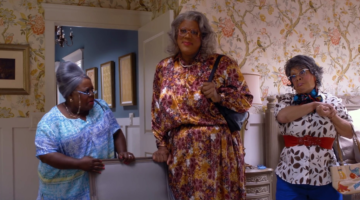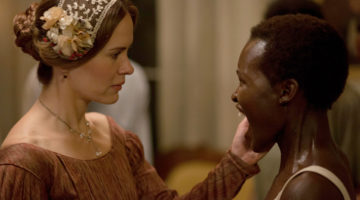Interview: Teresa Miller talks White God
We spoke to Hollywood dog trainer Teresa Miller about White God, why CGI was not an option, finding the perfect pair of dogs to play Hagen, creating the perfect dog fight scenes and how hundreds of real-life mutts found loving homes as a direct result of the film.
I understand that two dogs played the role of Hagen. Can you explain why that is?
It’s very common in a lot of your larger animal films, where the character of the dog has such a prominent place in the film. It’s for a number of reasons. One is an assurance to production because I can’t midday say well my dog’s tired now we can’t film anymore. The other thing it does is it actually doubles the personality and the character of that character role. So in other words if I’ve got a dog that’s really good, does actions fast, is very expressive but doesn’t show his teeth very good but he’s smart as a whip and he’s cute. Now it turns out that his brother shows his teeth, works a little bit slower is a little bit more of a nut – kind of carefree and silly in his actions. You put those two together and you just have this explosion of the Hagen character.
Were the two dogs used in the movie related?
Yes, they were brothers they were litter mates.
So these two dogs were up for adoption?
They were yes. They were in need of a home, they were accidental breedings at home. The family had a very small home and small children as well and they just couldn’t keep all four dogs.
Is that how you find dogs to work with, do you browse adoption ads and do you visit shelters?
Yes, I go to shelters a lot. The difficult part in this case was findings two dogs who looked alike. I went on rescue sites, I went to animal shelters, classified ads. I mean everything from Craigslist to eBay to Amazon. We searched for a good three months before we found pair of dogs that the director believed could be Hagen.
What was it specifically in terms of character or look that he was really focused on finding?
I had found one other team of dogs they were Rhodesian ridgebacks. Kind of a mix though, they weren’t pure Rhodesian ridgebacks. They were a pretty close photo double. Hagen’s character goes from this puppy lapdog living with this little girl and then eventually Dr. Jekyll, Mr. Hyde happens. His personality changed completely 180. The director didn’t really see it in the Rhodesian ridgebacks eyes they looked just a little too hard.
To do something like that, especially where they are being trained for the dog fighting scenes – and that’s not who the dog naturally is – is it just a play time thing for them or do they know it’s a job?
It’s completely play, completely play. So much so, that we filmed it over a five day period and we built the arena, the fighting arena, on the set and about a month ahead of time. That was their play date, every day, twice a day. Luke and Bernard were the two dogs that did the best wrestling match and they really liked each other. So they’d go in and grab ass and bite each other’s legs. The funny thing is, the Rottweiler (Bernard), the biggest problem with him is that he loves to scratch his back and wrestle on his back. When my dog would go over and bite him on the legs he would fall over right away and Kornel (Director Kornel Mundruczo) would go, wait, wait he’s got to fight more, he can’t die so quickly!
Roughly how many dogs were required for the film and what are the logistics of working with that many dogs?
It was a total of 280 dogs in the whole film and I guess the most we ran at one time was about 220, something like that.
The first physical challenge was that I was in America and there was no way to take that many dogs overseas. I had never seen that many dogs work together. I never even imagined it would be actual, I just imagined it would CGI or what have you. Talking with Kornel the director and production, they knew this animal trainer in Budapest (Arpad Halasz) who had this large training club. In talking to him they were encouraged because he believed he could put together these packs of dogs. They gave him four months to put just that together. All these dogs had to do was run from point A to point B. Working with his clientele and the local animal shelter he was able to form this huge packs of dogs to run.
It was important to Kornel that he kept the film really true to life and feeling, he didn’t want a lot of special effects, he didn’t want a human version of what that pack of dogs would look like.
Can you tell us a little about what goes into creating something like the final scene of the film?
The actual last scene was 200 dogs laying down and my dog in the center with the little girl. How that was accomplished was they made a plate of 50 dogs – which is still an accomplishment – to keep 50 dogs lying down in a film environment with crew an equipment and everything else around. So they shot a plate of 50 dogs and then reimposed it four times and that created the still of 200 dogs.
In the film the dogs are supposed to be mutts. Is it harder to train a group of dogs that are not all one breed?
As far as working with mixed breed dogs generally what’s been found is that you have your pure bred animals that were bred for one specific purpose and in general with these mixed breed dogs you get a combination of those specific purposes that have been bred into different breeds. You actually get a dog that’s a little more flexible.
All those shelter dogs that we worked with, they started out as very introvert dogs in the shelter. Some of them were very shy, some of them were very frightened, some of them were just kind of broken, you know spirit-wise. Three days a week they would go the shelter, load up the dogs and bring them to the ranch. They would have these play dates and all they had to do was run from one point to the other.
It’s interesting because after months of doing that these dogs really changed, I mean they had a purpose. You could see it in their spirit they had a job to do. It really helped in the adoption program to get these dogs homes because now they were socialized, they all knew how to walk on a leash, they all had their vaccinations. I think the adoption rate was up at 98 per cent from all those dogs we used from the shelter. It really gave them the ability to be dogs again.





